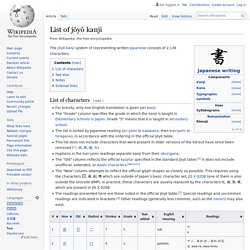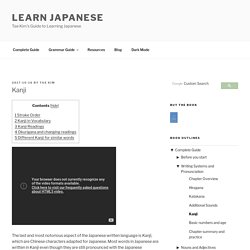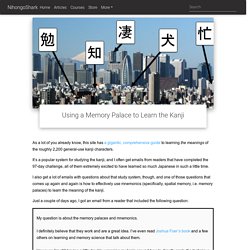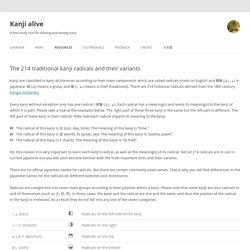

日 (Kanji for sun, day) Should a Japanese beginner learn the Onyomi, Kunyomi Kanji, or both? - Quora. Forum. Kanji alive Web Application. Kanji Listing. List of kanji by concept. List of jōyō kanji. From Wikipedia, the free encyclopedia Jump to navigationJump to search Wikipedia list of written Japanese characters The jōyō kanji system of representing written Japanese consists of 2,136 characters.

List of characters[edit] See also[edit] Notes[edit] ^ The Cabinet of Japan. External links[edit] Making It Memorable: Japanese Mnemonics for Dates and Kanji. A Samurai Lends a Hand Sometimes memory needs a helping hand.

While English speakers use “Thirty Days Has September” to remember which are the shorter months, the equivalent for young Japanese children is the phrase nishi muku samurai (the samurai looking west). First of all, ni, shi, mu, and ku sound like the numbers two, four, six, and nine, representing nigatsu (February), shigatsu (April), rokugatsu (June), and kugatsu (September). Then the samurai stands for jūichigatsu (November) because one way of writing it is 士, which looks very much like eleven (十一) with the second character written below the first. Number wordplay, known as goroawase, is deeply ingrained in everyday life in Japan. Goroawase examples by number Good Country, Good Box Goroawase is particularly useful when it comes to memorizing the years when important historical events took place.
There may be more than one version, as for 1603, the year that Tokugawa Ieyasu established the Edo shogunate. Lincoln’s Coffee. Japanese language learning, Learn japanese, Learn japanese words. Kanji: 聞. Jisho.org: Japanese Dictionary. Kanji. The last and most notorious aspect of the Japanese written language is Kanji, which are Chinese characters adapted for Japanese.

Most words in Japanese are written in Kanji even though they are still pronounced with the Japanese phonetic sounds represented by Hiragana and Katakana. Stroke Order When learning Kanji, it is very important to learn it with the proper stroke order and direction from the beginning in order to avoid developing any bad habits. Japanese learners often think that stroke order doesn’t matter as long as the end product looks the same. However, what they don’t realize is that there are thousands of characters and they are not always meticulously written the way they appear in print.
The simpler characters called radicals are often reused as components in larger characters. One good general rule of thumb is that strokes usually start from the top-left corner toward the bottom-right. Using a Memory Palace for Learning the Kanji - Japanese Mnemonics. As a lot of you already know, this site has a gigantic, comprehensive guide to learning the meanings of the roughly 2,200 general-use kanji characters.

It’s a popular system for studying the kanji, and I often get emails from readers that have completed the 97-day challenge, all of them extremely excited to have learned so much Japanese in such a little time. I also get a lot of emails with questions about that study system, though, and one of those questions that comes up again and again is how to effectively use mnemonics (specifically, spatial memory, i.e. memory palaces) to learn the meaning of the kanji.
Just a couple of days ago, I got an email from a reader that included the following question: My question is about the memory palaces and mnemonics.I definitely believe that they work and are a great idea. That’s a tall order, but I’ll try to walk through a few mnemonics to give readers a better idea of how I personally would go through the kanji if I were to start over completely. Henshall Kanji Mnemonics. Stroke Order Diagram for 楽 [raku] - Tanoshii Japanese. Romaji Hide Definition and Synonyms for 楽 Meanings for each kanji in 楽 Categories 楽 is a member of.
![Stroke Order Diagram for 楽 [raku] - Tanoshii Japanese](http://cdn.pearltrees.com/s/pic/th/diagram-tanoshii-japanese-199671166)
The Complete Guide to Japanese Kanji: Remembering and Understanding the 2 ... - Christopher Seely, Kenneth G. Henshall - Google Books. Kanji pict o-graphix. The 214 traditional kanji radicals and their meanings. Kanji are classified in kanji dictionaries according to their main components which are called radicals (roots) in English and 部首 (ぶしゅ) in Japanese.

部 (ぶ) means a group and 首 (しゅ) means a chief (head/neck). There are 214 historical radicals derived from the 18th century Kangxi dictionary. Ulrike's Mnemonics. How to Learn Japanese Kanji the fun way (Heisig) How To Learn Kanji in 6 Easy Steps: A Guide For Japanese Learners. So you’re starting out on your Japanese journey. Maybe you’re trying to follow along with your favorite song lyrics, or maybe you found a Japanese book or manga you’re super excited to read. How To Learn Kanji in 6 Easy Steps: A Guide For Japanese Learners.
夢 (Kanji for dream) Ulrike's Mnemonics. Learn Kanji with Radicals and Mnemonics: The Definitive Guide. Kanji is said to be the most difficult part of learning Japanese. The most common reasons for this are "there are a lot of them," or "they are complicated," or even "they are hard. " But if you know how to learn kanji, it doesn't need to be so hard. You don't need to spend 10+ years studying kanji to reach a decent level of Japanese literacy. One or two years will do, if you've got the right technique. Around five years ago, Tofugu made the kanji-learning application WaniKani to fix the "learning kanji" problem. Learn one Kanji a day with infographic: 情 (jou) – Japanesetest4you.com. Click on image to view full size. feelings, emotion, passion, sympathy, circumstances, facts On: jou, sei Kun: nasa.ke Feeling blue is a state of mind where you’re dominated by your feelings.
